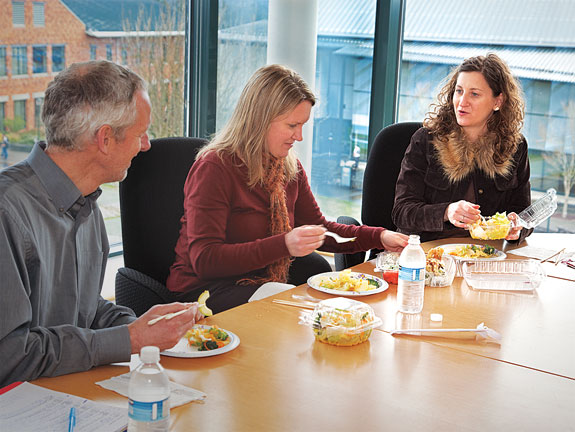Rebecca Portnoy started thinking about shared meals and came across a memory of closing time in a particular restaurant.
“I had been at a Seattle sushi restaurant at the end of the night, and the leftover sushi was being moved to a communal table for a staff meal,” says Portnoy, an assistant professor of management at WSU Vancouver. “I had worked at restaurants and I was baffled and amazed that they were going to take the time at the end of their shift to eat together.”
When she worked as a waitress, Portnoy usually saw people take off right after their shifts. She wondered, what was going on in the sushi place that’s so meaningful to those workers?
A shared meal is a daily experience for many coworkers, and the basis for some of Portnoy’s research questions. She asks what effect do shared meals have on work relationships? What is the experience of employees who join together for one of the most fundamental of human social activities, eating?
In her field of organizational behavior, she says, looking at shared meals “was a new idea, and there wasn’t literature on the effect of food or when people share.”
Portnoy’s research has a particular resonance in an era when more workers are taking fewer and shorter meal breaks, and eating alone more often—in the United States, 75 percent of office workers eat lunch at their desks two or three times a week according to a 2006 study.
Portnoy and doctoral student Doug Miller tested their questions about shared meals first with interviews of faculty members, and then with custodians at the Pullman and Vancouver campuses. They wanted to see if the sharing of a family-style meal could shed light on the development of relationships.
They heard from all participants that the freedom to talk removed them from certain work constraints, allowed them to connect personally, and even let them disclose complaints about work.
“It seemed no matter who we talked to, custodians or faculty, the experience of going to a meal with coworkers creates what we called liminal space,” says Portnoy. “There’s a boundary that’s created that separates the work culture from the meal culture.”
The shared meal also equalizes relationships among coworkers.
“There was this potential, because of the meal in a separate space, for the hierarchy or notion of hierarchy to dissipate. The role of supervisor who has authority over a person’s position or future in the company wasn’t present in the way it would be in a meeting,” says Portnoy.
Using the interview responses as a foundation, Portnoy is working on an empirical, quantitative study to better measure outcomes of shared meals.
What Portnoy and Miller study on a small scale, one company has taken to a much larger stage. Pullman-based Schweitzer Engineering Laboratories (SEL) hosts a Friday lunch for 3,000 of its employees every week.
Nancy Hindman ’84, chief operating officer and chief financial officer for SEL, says the Friday meal has been around since 1982, when Edmund O. Schweitzer III (’77 PhD), then a professor at WSU, started the company in his basement.
“They would order sandwiches from a deli or Dissmore’s and sit around his dining room table and talk about what happened that week,” she says.
Hindman joined the company, which designs and manufactures controls for electrical transmission, in 1989. At Friday lunch, they would talk about work—new customers, technical issues, products—as well as celebrate birthdays and babies.
She says the lunches developed into more structured events as SEL grew, but the company kept them going as a way to build the corporate culture, share information with all employees, and connect departments, both technical and non-technical.
The Pullman lunch is broadcast and recorded for all 89 branches worldwide. Each lunch features reports from several departments, an educational presentation, and a welcome for new employees.
“Every new employee who is in Pullman gets introduced in their first week of work. They talk about where they lived, their last job, and why they wanted to come work for SEL,” says Hindman.
The Friday lunch has attracted attention nationally. In January this year, Fortune magazine placed SEL at number 97 among the top 100 companies to work for in the nation, partly on the basis of its shared meal.
Hindman says the benefits of keeping every employee informed and engaged far outweigh the cost of providing the lunch, particularly since SEL is employee-owned.


